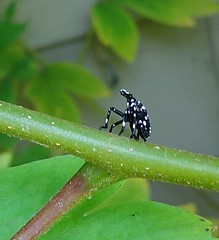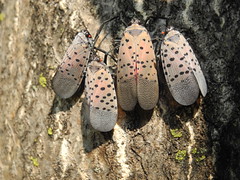SPOTTED LANTERNFLIES are named after flies, look like moths, but are actually planthoppers. They have piercing-sucking mouthparts which allow them to drill into the phloem of a plant to feed directly on the sugary sap—which comes out their other end as sticky, sweet honeydew.
This planthopper is thought to have arrived as egg masses on a stone shipment in 2012. The first infestation was found in Berks County, Pennsylvania in 2014 in a wooded area of Ailanthus altissima, the Tree of Heaven. Despite a quarantine of the townships involved, and efforts to eradicate this pest, the spotted lanternfly has proved difficult to contain and its range now includes infestations in New York.
What Do Spotted Lanternflies Look Like?
The name lanternfly is misleading; spotted lanternflies have little in common with any type of fly. Another misconception arises when viewing adults with wings spread, making them look like moths. Spotted lanternflies are planthoppers in the order Hemiptera, or true bugs, and are more closely related to cicadas, brown marmorated stink bugs, aphids, and leafhoppers.

(Shown above) The first instar nymphs are active from May until July and are approximately ¼” long and black with white spots. They are occasionally mistaken for ticks. Second and third instar nymphs are also black with white spots.

(Shown above) Fourth instar nymphs take on a red coloration with white spots and can be up to ¾”. This stage is active from July through mid-August; they then molt and become adults. All nymphal stages and adult spotted lanternflies can use their powerful hind legs to jump impressive distances.

Many photos show adult SLF with their wings open, including the red underwings, but in nature this only occurs when the SLF is startled or is ready to take flight. It is much more common to see the 1″ adults at rest with black-spotted, pinkish-tan wings folded over their backs. Both male and female SLF have yellow abdomens with black stripes.
Would you like a clear explanation of what spotted lanternfly are and why we are concerned? Here’s Brian Eshenaur’s presentation given to our First Friday audience in March of 2021 (30 minutes):
This blog post is adapted from our website. Click here for more information on Biology: Life Cycle, Identification, and Dispersion.
MUCH HARDER TO SEE IN LATE FALL!
After adult spotted lanternflies are killed by freezing temperatures and before they hatch in May, is a good time to look for and remove egg masses. Check for the egg masses on tree trunks, branches, rocks, lawn furniture, and really anything that’s outside. The egg masses are often found on the underside of branches or objects and vary in size but typically are about 1 1/2″ long and and 3/4″ wide and look like grayish splotches of mud or putty. Scrape these egg masses into a re-sealable bag which contains rubbing alcohol or hand sanitizer and dispose of them in the solution to be assured they will not hatch.
Because spotted lanternflies lay many egg masses high up in tree canopies, removing egg masses within reach will not eliminate them, but because each egg mass contains up to 50 eggs, it can reduce the numbers, especially early in the season.
OUR FULL RESOURCES ON SPOTTED LANTERNFLY ARE AVAILABLE ON OUR WEBSITE AT: https://nysipm.cornell.edu/environment/invasive-species-exotic-pests/spotted-lanternfly/